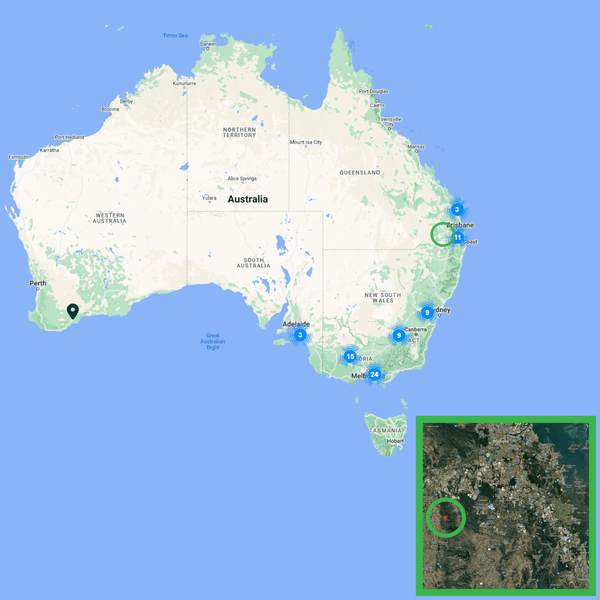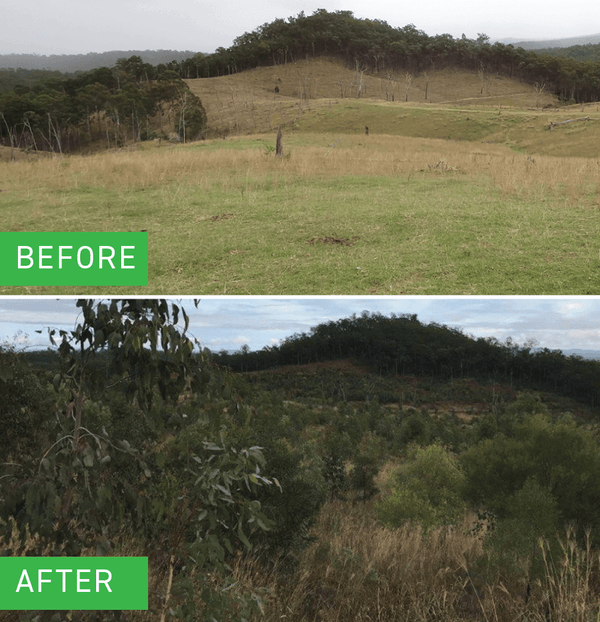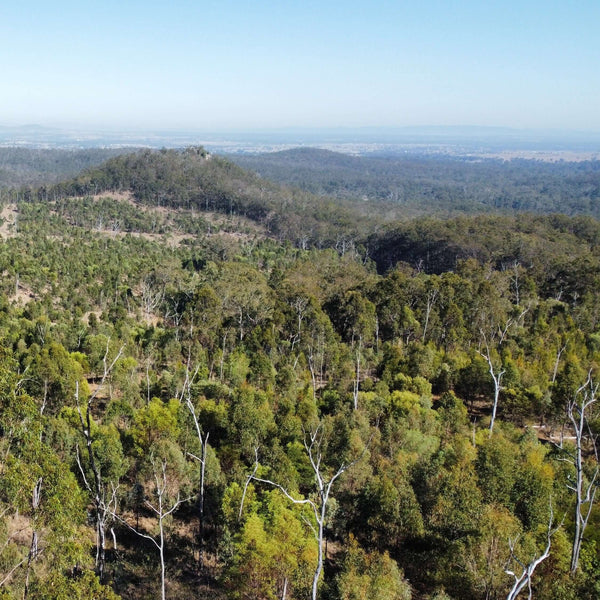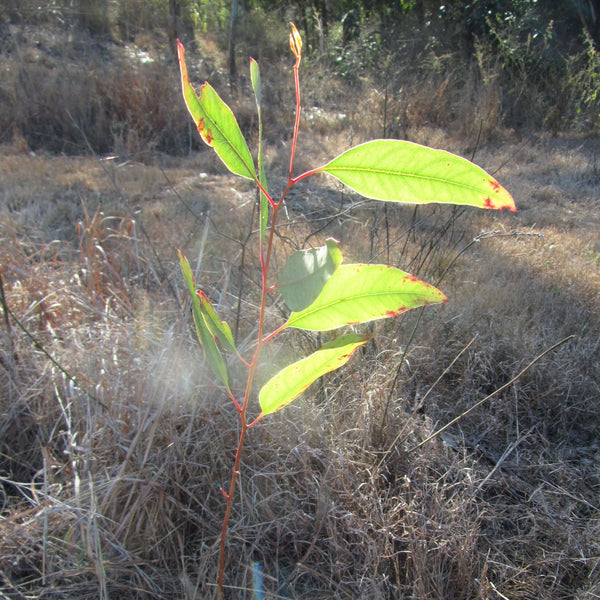Greenfleet revegetated this 95-hectare parcel of land in partnership with Queensland Trust for Nature (QTFN), between 2016 and 2020. Located on Yuggera Country, this property was cleared for cattle grazing decades ago.
The forest growing at Koala Crossing is restoring and protecting extensive areas of woodland and forest ecosystems that were once dominant in the region. This project is providing vital habitat for koalas and other native wildlife while removing carbon from the atmosphere.

Location & Map
This forest is growing at the foot of Flinders Peak, just one hour south-west of Brisbane. The region is prime koala habitat, made up of open eucalypt woodland and rocky escarpments. Sitting at the top of the Purga Creek catchment, Koala Crossing is growing to improve the water quality of this creek and provide ongoing environmental benefits.
The project is part of the Flinders Karawatha Corridor, the largest remaining continuous stretch of open eucalypt forest in Southeast Queensland. QTFN purchased several adjoining properties in this region, which now form Koala Crossing.

Improving Water Quality
One of the important environmental benefits of this project is improving water quality in the adjoining Purga Creek catchment. By planting the site out with thousands of native trees, we are helping to retain sediment and prevent further erosion occurring in the creek.
Nearby, Greenfleet also worked on another reforestation project on a site appropriately called Purga Creek. Located 8km downstream from Koala Crossing, we restored this site in 2007.

Importance Of Restoring Koala Habitat
Koalas are listed as endangered in Queensland, New South Wales, and the ACT. In 2015, figures from the Southeast Queensland Koala Population Modelling Study[1] found that in parts of Southeast Queensland more than 80 per cent of the koala population had disappeared since 1996.
The devastating bushfires of Black Summer in 2019 and 2020, resulted in the loss of more than a billion native Australian animals. Restoring habitat is more important than ever, particularly for protecting remaining populations of koalas and other threatened species from extinction.
When QTFN purchased the property, they estimated that there were between 10 and 20 koalas on the property. Surveys in 2020 showed that koala populations had already increased in abundance.
The forest planted at Koala Crossing represent the four different ecosystems occurring on the property. One of the tree species planted, the Queensland blue gum (Eucalyptus tereticornis), is a preferred food source for koalas, insects and birds. These trees can grow up to 50 metres with a trunk diameter of up to two metres.
As well as providing habitat for koalas, this forest will support brush-tailed rock wallabies, which have been found on this site. These large, agile rock wallabies are listed as vulnerable in NSW and Southeast Queensland.

Species Selection & Revegetation Approach
Koala Crossing has four different ecosystems occurring on the property, one of which is endangered, the spotted gum on trachyte geology. Due to land clearing and fires, this ecosystem is now reduced to 10-30% of its original area.
Greenfleet has planted weeping paperbark (Melaleuca irbyana), a tree that is now endangered due to the clearing of native vegetation. By legally protecting our forests on title, we are safeguarding the survival of these vulnerable plants and ecosystems.
Climate Action
The forest growing at Koala Crossing is legally protected for 100 years. Over that time, it will remove around 100,000 tonnes of carbon from the atmosphere, which is the equivalent of what over 23,050 average vehicles emit on Australia’s roads in a single year.
Location Size
95 ha at the foot of Flinders Peak, south of Brisbane, Queensland.
Planting Dates
2016, 2018, 2020
Species
- Blackwood (Acacia melanoxylon)
- Weeping myall (Acacia pendula)
- Coast wattle (Acacia sophorae)
- Prickly moses (Acacia verticillata)
- Silver wattle (Acacia dealbata)
- Sydney golden wattle (Acacia longifolia)
- Cootamundra wattle (Acacia baileyana)
- Kangaroo thorn (Acacia paradoxa)
- Buloke (Allocasuarina luehmannii)
- Forest oak (Allocasuarina torulosa)
- Red ash (Alphitonia excelsa)
- Broad-leaved apple (Angophora subvelutina)
- Kurrajong (Brachychiton populneus)
- River oak (Casuarina cunninghamiana)
- Spotted gum (Corymbia citriodora subsp. varigata)
- Pink bloodwood (Corymbia intermedia)
- Morton bay ash (Corymbia tessellaris)
- Narrow-leaved ironbark (Eucalyptus crebra)
- Forest red gum (Eucalyptus tereticornis)
- Black box (Eucalyptus largiflorens)
- Grey ironbark (Eucalyptus paniculata)
- Red-flowering gum (Corymbia ficifolia)
- Yellow gum (Eucalyptus leucoxylon)
- Dagger hakea (Hakea pugioniformis)
- Queensland brush box (Lophostemon confertus)
- Red gum (Angophora costata)
- Black tea-tree (Melaleuca bracteata)
- Weeping paperbark (Melaleuca irbyana)
- Weeping bottlebrush (Melaleuca viminalis)
References
[1] South East Queensland Koala Population Modelling Study
[2] Draft South East Queensland Koala Conservation Strategy: Community Summary


